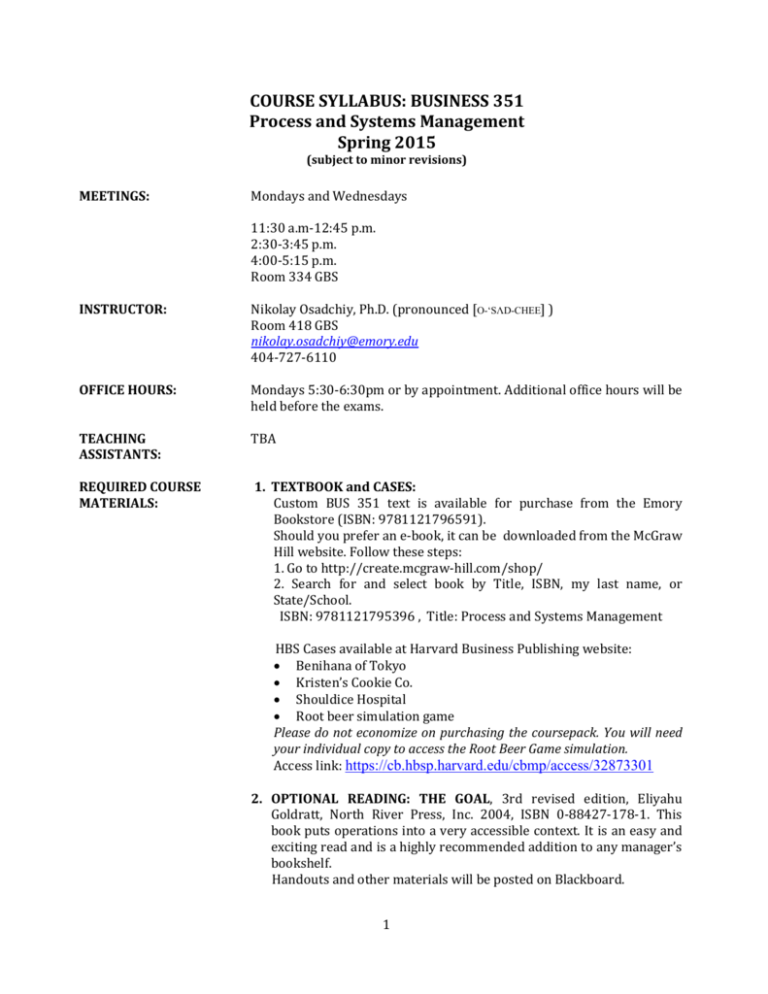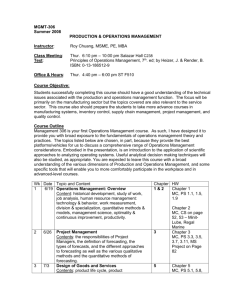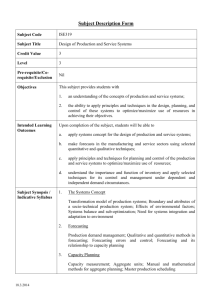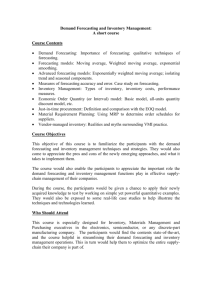COURSE SYLLABUS - Emory Goizueta Business School Intranet
advertisement

COURSE SYLLABUS: BUSINESS 351 Process and Systems Management Spring 2015 (subject to minor revisions) MEETINGS: Mondays and Wednesdays 11:30 a.m-12:45 p.m. 2:30-3:45 p.m. 4:00-5:15 p.m. Room 334 GBS INSTRUCTOR: Nikolay Osadchiy, Ph.D. (pronounced [O-‘SΛD-CHEE] ) Room 418 GBS nikolay.osadchiy@emory.edu 404-727-6110 OFFICE HOURS: Mondays 5:30-6:30pm or by appointment. Additional office hours will be held before the exams. TEACHING ASSISTANTS: TBA REQUIRED COURSE MATERIALS: 1. TEXTBOOK and CASES: Custom BUS 351 text is available for purchase from the Emory Bookstore (ISBN: 9781121796591). Should you prefer an e-book, it can be downloaded from the McGraw Hill website. Follow these steps: 1. Go to http://create.mcgraw-hill.com/shop/ 2. Search for and select book by Title, ISBN, my last name, or State/School. ISBN: 9781121795396 , Title: Process and Systems Management HBS Cases available at Harvard Business Publishing website: Benihana of Tokyo Kristen’s Cookie Co. Shouldice Hospital Root beer simulation game Please do not economize on purchasing the coursepack. You will need your individual copy to access the Root Beer Game simulation. Access link: https://cb.hbsp.harvard.edu/cbmp/access/32873301 2. OPTIONAL READING: THE GOAL, 3rd revised edition, Eliyahu Goldratt, North River Press, Inc. 2004, ISBN 0-88427-178-1. This book puts operations into a very accessible context. It is an easy and exciting read and is a highly recommended addition to any manager’s bookshelf. Handouts and other materials will be posted on Blackboard. 1 COURSE DESCRIPTION Whether you are an accountant, an entrepreneur, an analyst on Wall Street, a lawyer, a partner at McKinsey, or a manager at IBM, how you do your work is an important issue. With that in mind, this course examines the issues of managing business processes and operations in services and manufacturing, with a specific focus on understanding, improving and, ultimately, innovating operations and business models. Topics studied include operations strategy, forecasting, process analysis, process variability and waiting lines, quality, inventory, and supply chain management. The two main themes of this course are -- (1) matching supply and demand, and (2) innovation of business models – both equally important for maintaining competitive advantage of a firm. The course will also give you a ready-to-use set of general-purpose mathematical models and data analytics tools that can be applied in many functional areas spanning a range of occupations including general management, consulting, finance, healthcare, and entertainment. COURSE OBJECTIVES This course has several objectives: To help students understand the mechanisms behind façade of the business, that is, its operations or how it really works. To help students analyze and make decisions based on the business and operations related data. Provide a working knowledge of the operations function. Examine and explore the relationship between operations management issues and the other functional areas of the firm (such as finance, marketing, etc.) To give the student a working knowledge of the tools and techniques used by operations professionals and data scientists in managing systems and processes, and in setting operations policy. To provide a basic set of information for the student interested in a career in operations/consulting/data analytics as a foundation for future coursework. PRE-REQUISITES The course is quantitative. Everyone in the class should have completed the pre-requisites of the degree program, including BUS 350 or its equivalent. College-level calculus, and statistics usually prove to be very helpful in the course. We will use MS Excel for some problems, basic familiarity with the spreadsheet software is expected. I will cover some more advanced issues (such as Solver, simulation, or regressions) when needed. 2 HONOR CODE I expect every student to be familiar with the Goizueta Business School Honor Code. Some of the ways in which the code applies to this course are discussed below: The honor code stipulates that no student will lie, cheat, copy or otherwise behave in an unfair manner to obtain academic advantage over other students. As per the honor code, an individual’s name on a report should be included only if they have contributed to the analysis. If an individual has not contributed to the analysis in an intellectual manner, it is a violation of the honor code to include his or her name. Furthermore, you may not refer to case/homework write-ups from classes offered in earlier semesters. The premise of the honor code is that ideas should be attributed to their source. Therefore, please acknowledge the main source(s) of data, facts, and ideas (other than from the instructor or textbook) in all your written work and when you make a presentation. If you use material from a source other than the lecturer, the textbooks or the lecture notes, you must attribute the source. For example, say, “I discussed this with the TA.” Or “I obtained this from the following website.” You may discuss the homework with your classmates, TA or me. However, you must do and write them up individually. The discussion is limited to “how to solve” type of questions. The actual solution must be done individually. Do not be worried of getting the answer incorrect in the homework. Most of the points will be given for using the correct approach. CLASS PROCEDURE The procedures followed in this class will be similar to those followed in other business courses. The primary method of instruction is lecture with student participation, including in-class group work. We will use class time to further develop the material from the chapters rather than just review it. Hence, it is to your advantage to read the assigned text before class. If the assigned text is a case, please be sure to read it carefully and be prepared to be called upon to present the facts of the case. GRADING Class Participation Homework Group project Mid-Term Examination Final Examination 10% 20% 20% 25% 25% 3 CLASS PARTICIPATION AND ATTENDANCE POLICY Class participation constitutes 10% of your final course grade and will be based on: 1) attendance (5%), 2) contributions to in-class discussions, and online forums, such as discussions on the class blog Operations Club 351 (http://opsclub351.wordpress.com), or Blackboard (5%). Missing five or more classes is considered excessive, and will negatively impact your grade (1% deduction, or 2% if missed 8 or more classes). If you miss a class, I expect you to get the notes and be familiar with the material by the next class. You are responsible for all material covered in class during your absence, including new assignments. Additionally, material not in the text will be presented in class. This material will be included in the exams. HOMEWORK There are six homework assignments. The homeworks are to be handed-in as a HARD COPY at the beginning of class. Late work will be penalized by 1/10 of the homework value if it is submitted the same day it is due. Assignments will not be accepted after the day they are due. You may want to keep a copy of all homework submitted for your reference. When discussion questions are involved, please answer briefly (two or three sentences). Homework must be prepared individually in order to receive credit. Identical copies will not receive credit and will be considered Honor code violations. One make up homework will be distributed before the final review. You can use it to make up for one missed homework or to improve any homework grade you received in the class. PROJECTS Project groups will consist of 5-6 people from your section. Each group will be required to either 1) assemble and analyze a dataset reflecting operations of a company or organization in or outside the US or 2) select a firm in the Atlanta area and analyze the effectiveness of its operating model. I am happy to discuss data sources with you or help you to secure the participation of the company (with a letter or a phone call). Additional comments about the projects are provided at the end of the syllabus. Please start working on the project early, as it is an important component of your class grade. EXAMINATIONS There will be a midterm and a final exam. The exams are not cumulative. One double sided “cheat-sheet” is permitted. No laptops or smartphones will be allowed. Please bring regular calculators. The duration for the midterm is 75 minutes and for the final is 90 minutes. The midterm be held without exception in your own class section on the date specified in the course schedule. The final will be given at the time set by the Registrar’s office. Exceptions to the policy of taking the final at the time scheduled are rare. “A plane ticket home” is not an acceptable reason for requesting a final exam move. 4 EXTRA CREDIT There may be occasional opportunities for extra credit throughout the semester, such as a make-up homework or extra-credit problem on the exam. No additional extra credit aside from these opportunities will be offered, i.e., no individual requests for additional extra-credit will be considered. OTHER ISSUES As you are about to enter the professional world, your work should be of professional quality. Hence, presentation matters. The following guidelines will help you understand my expectations as you prepare assignments. Use a computer for writing assignments. You may use a pencil or pen for problems, but make sure the work is legible. Staple multiple pages together. Please do not dog-ear them, paper clip them, binder-clip them or put them in plastic covers. Proofread your work carefully. 5 COURSE SCHEDULE Date 01/14 W # 0 Topic Readings Managing operations and Chapter 1 innovating business models Important Events 01/21 01/26 01/28 02/02 02/04 02/09 W M W M W M 1 1 1 1 2 2 Innovations in services Operations strategy Forecasting Forecasting Process Analysis Process Analysis Benihana of Tokyo case Chapter 1 Chapter 2 Chapter 2 Chapters 3 and 4 Kristen’s Cookie case 02/11 02/16 02/18 W M W 2 3 3 Process Analysis Waiting line models Multi server queues 02/23 02/25 03/02 03/04 M W M W 3 - Chapters 3 and 4 Chapter 5 FCNB Case (posted on BBoard) Chapter 5 Simulation of queues Review session Homework 3 due Midterm Exam No class: use this time to prepare (optional) Chapter 8, the project plans other materials on Bboard 03/16 M 4 Innovations in quality Shouldice Hospital case Project plans due 03/18 03/23 03/25 W M W 4 4 5 Total Quality Management Statistical quality control Inventory management Chapter 6 Chapter 6 Chapter 7 Homework 4 due 03/30 M 5 Inventory management 04/01 04/06 04/08 W M W 5 6 6 Xenon case (posted on BBoard) Chapters 7 and 9 Inventory management Playing the Beer Game Beer Game discussion & Just-in- Chapters 7 and 9 time 04/13 M 6 Innovations in management 04/15 W - Presentations 04/20 M - Presentations 04/21 04/27 TBD W M - Presentations Review session Final Project groups due Homework 1 due Homework 2 due Homework 5 due supply chain Exec summaries, project reports due Homework 6 due Exam 6 PROJECT REQUIREMENTS 1. Overall Assignment: Collect and analyze data on operations of a company or a system (for example, FAA reports performance metrics of the US airlines http://www.faa.gov/data_research/, and the city of London shares a lot of data on its operations http://data.london.gov.uk/) and present your findings. Alternatively, you could select a company with operations in the Atlanta area. Meet with managers or employees at the company to lean about their operations and identify current issues and opportunities for improvement. 2. Deliverables: An Executive Summary of the project (no more than 2 pages), a Research Report (no more than 10 pages) and a presentation (approximately 15 minutes). The summary and report should be submitted as a hard and electronic copy on the first day of presentations. The presentation or a link to presentation (if you use Prezi) should be submitted electronically on the day of your presentation. The Executive Summary should clearly tell what data or company you studied, what are the most pressing issues, and possible ways to address them (20% of total project grade). The Research Report should give more detail about how you analyzed the problem (50% of total project grade). The presentation should be done like a pitch to a management team (30% of total project grade). In other words, assume general knowledge. 3. Issues to make the project easier for you: Be an active member of your team. There will be peer evaluations at the end of the project. If you decide to analyze a company, pick one which is interesting, or where you have vested interest (e.g., family, friends, or your own business). Some of the best projects in the past involved a small Atlanta-based airline, American Red Cross, Emory EMS, a crowdsourcing fashion start up, a small business shoe store, a biodiesel fueling station, etc. Also, some very interesting projects involved analyzing vehicular traffic around Emory, for example, design of intersections (crossing or roundabout), optimization of shuttle routes, and optimization of traffic light timings. Be cautious about analyzing restaurants, apartment complex maintenance, and car washes. These generally end up solely being staffing questions. Be creative about your choice of the data set. We live in the age of Big data, so try to think outside the box. Some ‘traditional’ sources of data would include: US government (US Census, FAA, Customs data to name a few), Wharton Research Data Services (Compustat, IBES, etc), databases available through Emory Library (Factiva, Bloomberg, Thompson Reuters, S&P, etc). Some less ‘traditional’ but no less exciting data could include social networks (some successful projects in the past obtained data from Twitter API), consumer review websites, price aggregators, traffic cameras, internet infrastructure load data, online stores, car and bike sharing systems data, etc. I will post some data sources on Bboard. Having a unique data set is often the key to success! Check the OpsClub351 blog for some project ideas and Hall-of-famers. Focus on analysis of the operations, and be careful about your recommendations. Learn about the company or organization. They probably have been in the business for a while, so there must be a reason for why the things work the way they are. As a rule of thumb, dedicate at least 80% of your 7 report and presentation to describing and analyzing the organization and the data, and at most 20% to recommendations. Although some overlap with neighboring fields, such as marketing and finance is bound to happen, be sure that your project is mainly about operations. To get some ideas about how to position your projects within a bigger picture of a company’s business, reading Chapter 8 in your text would be a good start. I am available to meet with you, if your group chooses. There are two main purposes to the presentation: to tell your classmates and me about your project, and to give you the experience of making a pitch. Think strategically about how you want to design it. When you design your pitch, use graphics, clip art, sound, whirling things and the like only as they make your pitch better. If you look at a McKinsey pitch, it is done in a simple font, with a plain background, with no clip art, subtle slide transition effects, and relatively few moving parts. Having said that, pictures/videos from the field are usually well received, as well as newer presentation tools, such as Prezi or PPTFlex (free download at MS Office Labs). I don’t require each team member stand up and talk. The allocation of work for this project is a group decision. It’s OK to have “number crunchers” and “smooth presenters”. Please don’t use binders or plastic covers for your project report, just a staple. The 10-page Research Report requirement is a MAXIMUM. You don’t have to turn in 10 pages. Just make sure your project is clear (I’d imagine 6 pages is a practical minimum). The page count does not include appendices. Use bulleted lists, tables and diagrams to increase clarity. Please feel free to invite your contact from the company for the presentation. I may also contact your company representative to evaluate the quality of your work from their perspective. Be sure that your recommendations follow from your assumptions and analysis. For example, if you analyze the capacity of a company, recommending the company change forecasting methods probably does not follow from your analysis. 8 BUS 351: Detailed Sessions Description Module 0: Introduction Class 1: Introduction to Operations Management This class will cover the course syllabus and provide a brief overview of operations management. We will develop a process view of organization, and see how effective operations management can reduce mismatch between demand and supply. We will briefly talk about interaction between operations and other functional areas of the firm. Read: Chapter 1 Module 1: Operations Strategy Class 1: Innovations in services In this class we will talk about the interaction between strategic goals of a company and its operations using an example of innovative approach to restaurant business at Benihana of Tokyo. In the end, I will give you a gentle introduction to a very powerful tool – Little’s law and show how it can be used to decide on the size of Benihana’s bar lounge. Case: Benihana of Tokyo How do operational choices at Benihana contribute to its competitive advantage? Class 2: Key concepts in operations strategy In this class we will look at the strategic planning hierarchy and discuss the four core competencies of a company – cost, quality, responsiveness, and flexibility. We will define an operational tradeoff and the concept of efficient frontier. I will give you the tools for characterizing manufacturing and service processes. Read: Chapter 3 - section 2.6, Chapter 5 – p 123-125 Class 3: Forecasting In this class we will talk about importance of forecasting for achieving strategic goals of a company. I will introduce you to the following time series forecasting methods: moving average, weighted moving average, and simple exponential smoothing. We will discuss how the parameters of the methods can be optimized for minimizing the forecast error and do a practical example in Excel. You may bring your computers. Read: Chapter 2 9 Class 4: Forecasting with trends and seasonality We will continue talking about forecasting. I will give a brief recap of a simple linear regression and show how it can be used for forecasting trends and causal relationships. Then I will introduce you to the exponential smoothing with trend adjustment and regression forecasting with seasonality. I will show you how all the methods can be implemented in Excel. For best results – bring your computers. Module 2: Process Analysis Class 1: Measuring a process Forecasting has mostly to do with the demand side of a company. In this class we will look at the supply side. We will see how a production or service delivery process can be described and measured step by step. I will introduce the key concepts of process analysis, including capacity, bottlenecks, and inventory. Read: Chapter 3 Class 2: Kristens’ Cookies Case We will analyze the classic Harvard case Kristen’s Cookies Company and apply our knowledge from the previous class. I will introduce you the Gantt Chart. Case: Kristen’s Cookies Company Use questions at the end of the case to prepare for the class Class 3: Process and product decisions In this class we will continue using the Kristen’s Cookies case as an example to see how operational decisions can impact marketing decisions and vice versa. I will introduce you to the concept of margin per minute of the bottleneck time. Read: Chapter 4 Module 3: Process Variability and Waiting Lines Class 1: Process variability and queues I will introduce you to the Buffer or Suffer principle. We will see how variability in demand or process capacity can impact the flow rate of the process and lead to accumulation of inventory or queue. I will define a simple model of a single server queue and discuss its underlying assumptions, including the Poisson arrival process and exponential service times. I will show you how to compute average utilization, queue size, and waiting time. We will see why in the presence of variability it is impossible to operate with 100% capacity utilization. Read: Chapter 5 10 Class 2: Queues with multiple servers We will look at the scaled up version of a service system that has more than one server and compare it with a single server queue. We will discuss the economics of queues, including servers’ labor cost and customers’ cost of waiting. We will compute the average queue length and learn how to select the optimal number of servers for a queue. We will apply this knowledge to the FCNB case. Case: First City National Bank (FCNB) Read and know the details of the case. Class 3: Simulation of queues In this class we will complete analysis of the FCNB case. I will show you how to simulate a queue under very general assumptions. We work together to implement the simulation of the FCNB queue in Excel. Bring your computers. Module 4: Quality Management Class 1: Quality management In this class, we will examine the quality implications of the innovative and focused service delivery process at Shouldice Hospital. We will discuss the importance of quality management and costs of quality. Case: Shouldice Hospital How operational decisions made by Shouldice hospital contribute to its performance? Class 2: Total quality management In this session we will talk about quality management and continuous improvement. I will define the concept of conformance quality and introduce statistical methods for managing process quality. Read: Chapter 6 Class 3: 6-sigma In this class we will continue talking about the statistical process control methods. I will introduce you to the concept of 6-sigma and show its implications for the product quality and production process control. Module 5: Inventory Management Class 1: Economics of inventory 11 In this class, we will recap the reasons for inventory from the Process Analysis module and define the costs associated with inventory. I will introduce you to a simple inventory model called Economic order quantity or EOQ that can be used when demand is well known. Read: Chapter 7 Class 2: Economies of scale In this class we will examine a source of efficiency of large companies, such as Walmart, economies of scale. We will look into implications of economies of scale for inventory. Case: Xenon Inc. Class 3: Betting on uncertain demand with inventory In this class we will examine implications of demand uncertainty for inventory management. I will define the concept of safety stock and show how to compute it. Then I will introduce a so called newsvendor problem and show how it can be used to select the optimal level of inventory or by how much overbook an airplane. Read: Chapter 7 Module 6: Supply Chain Management Class 1: Beer Game simulation In this class you will apply your knowledge of inventory management, and demand forecasting. You will be taking part in the online simulation of a Root Beer supply chain, making decisions about root beer production, distribution, and retailing. You will be automatically registered for the simulation after your purchase of the Harvard case pack. Bring your computers. Class 2: Current issues in supply chain management In this session, we will learn from the results of the Beer game, and talk about lean supply chains and the Bullwhip effect. In addition, we will discuss the problem of risks, incentives, and coordination in supply chain. I will show how simple buy-back or revenue sharing contracts can improve supply chain efficiency. I will draw on my research and talk about supply chain risks. Read: Chapter 9 Class 3: Innovations in supply chain management In this class we will wrap up the course by looking at the innovative business models using the example of the Spanish retailer Zara (among others). We will see how a lean and responsive supply chain of Zara is critical for its performance. Having completed the full circle in this class, we will see how innovative and seemingly counterintuitive operational decisions contribute companies’ competitive advantage. 12






